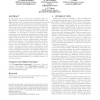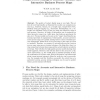954 search results - page 175 / 191 » Principles and Models for Organizing the IT Function |
NECO
2000
13 years 7 months ago
2000
Recent advances in the technology of multi-unit recordings make it possible to test Hebb's hypothesis that neurons do not function in isolation but are organized in assemblie...
EMSOFT
2009
Springer
14 years 2 months ago
2009
Springer
An important step in model-based embedded system design consists in mapping functional specifications and their tasks/operations onto execution architectures and their ressources...
DMIN
2006
13 years 9 months ago
2006
are proposing a model to help organizations detect and prevent cheats in online assessments. First we analyze different student personalities, stress situations generated by onlin...
BIS
2009
13 years 8 months ago
2009
Abstract. The quality of today's digital maps is very high. This allows for new functionality as illustrated by modern car navigation systems (e.g., TomTom, Garmin, etc.), Goo...
BMCBI
2005
13 years 7 months ago
2005
Background: Phylogenetic footprinting is the identification of functional regions of DNA by their evolutionary conservation. This is achieved by comparing orthologous regions from...


